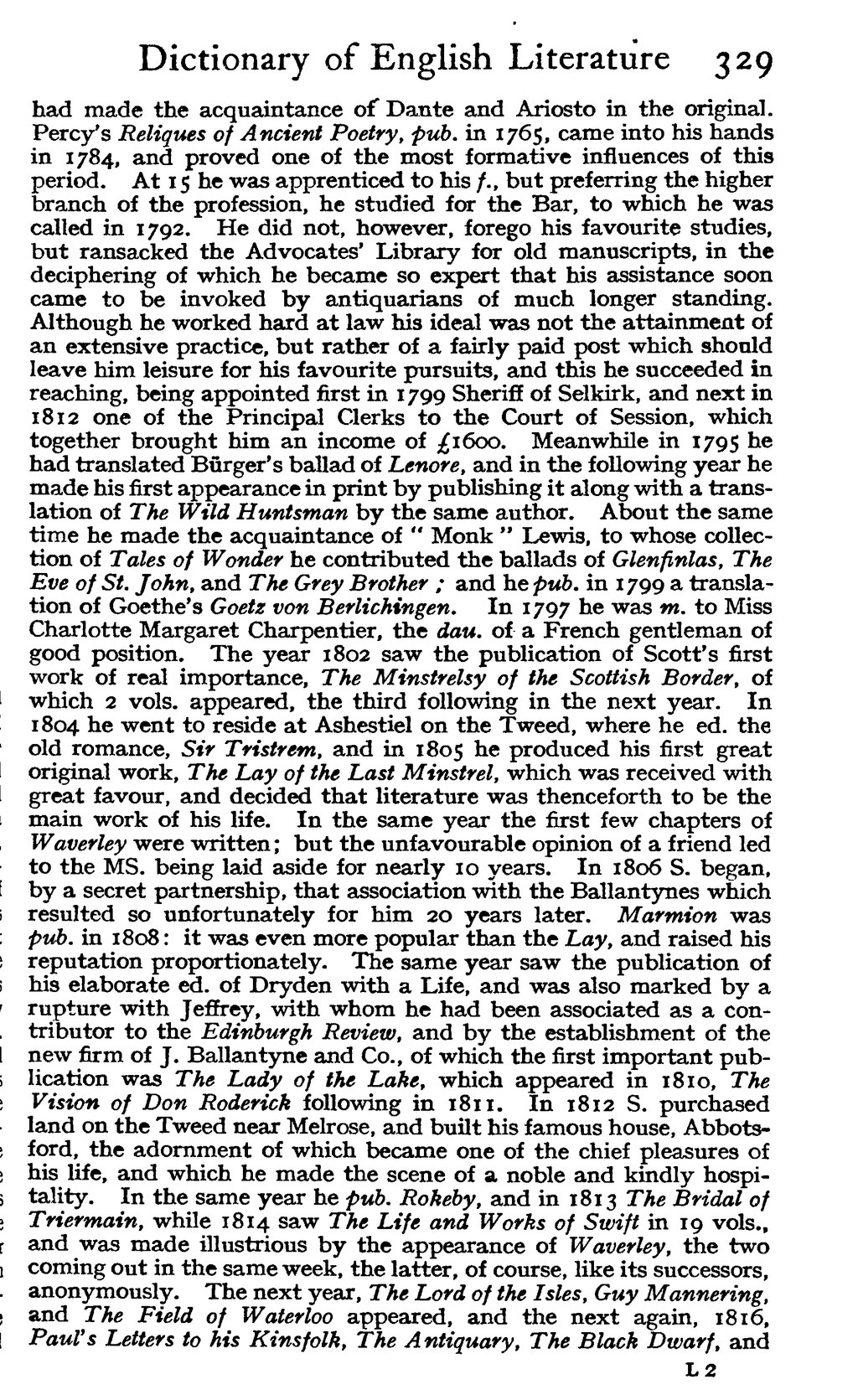had made the acquaintance of Dante and Ariosto in the original. Percy's Reliques of Ancient Poetry, pub. in 1765, came into his hands in 1784, and proved one of the most formative influences of this period. At 15 he was apprenticed to his f., but preferring the higher branch of the profession, he studied for the Bar, to which he was called in 1792. He did not, however, forego his favourite studies, but ransacked the Advocates' Library for old manuscripts, in the deciphering of which he became so expert that his assistance soon came to be invoked by antiquarians of much longer standing. Although he worked hard at law his ideal was not the attainment of an extensive practice, but rather of a fairly paid post which should leave him leisure for his favourite pursuits, and this he succeeded in reaching, being appointed first in 1799 Sheriff of Selkirk, and next in 1812 one of the Principal Clerks to the Court of Session, which together brought him an income of £1600. Meanwhile in 1795 he had translated Bürger's ballad of Lenore, and in the following year he made his first appearance in print by publishing it along with a translation of The Wild Huntsman by the same author. About the same time he made the acquaintance of "Monk" Lewis, to whose collection of Tales of Wonder he contributed the ballads of Glenfinlas, The Eve of St. John, and The Grey Brother; and he pub. in 1799 a translation of Goethe's Goetz von Berlichingen. In 1797 he was m. to Miss Charlotte Margaret Charpentier, the dau. of a French gentleman of good position. The year 1802 saw the publication of Scott's first work of real importance, The Minstrelsy of the Scottish Border, of which 2 vols. appeared, the third following in the next year. In 1804 he went to reside at Ashestiel on the Tweed, where he ed. the old romance, Sir Tristrem, and in 1805 he produced his first great original work, The Lay of the Last Minstrel, which was received with great favour, and decided that literature was thenceforth to be the main work of his life. In the same year the first few chapters of Waverley were written; but the unfavourable opinion of a friend led to the MS. being laid aside for nearly 10 years. In 1806 S. began, by a secret partnership, that association with the Ballantynes which resulted so unfortunately for him 20 years later. Marmion was pub. in 1808: it was even more popular than the Lay, and raised his reputation proportionately. The same year saw the publication of his elaborate ed. of Dryden with a Life, and was also marked by a rupture with Jeffrey, with whom he had been associated as a contributor to the Edinburgh Review, and by the establishment of the new firm of J. Ballantyne and Co., of which the first important publication was The Lady of the Lake, which appeared in 1810, The Vision of Don Roderick following in 1811. In 1812 S. purchased land on the Tweed near Melrose, and built his famous house, Abbotsford, the adornment of which became one of the chief pleasures of his life, and which he made the scene of a noble and kindly hospitality. In the same year he pub. Rokeby, and in 1813 The Bridal of Triermain, while 1814 saw The Life and Works of Swift in 19 vols., and was made illustrious by the appearance of Waverley, the two coming out in the same week, the latter, of course, like its successors, anonymously. The next year, The Lord of the Isles, Guy Mannering, and The Field of Waterloo appeared, and the next again, 1816, Paul's Letters to his Kinsfolk, The Antiquary, The Black Dwarf, and
